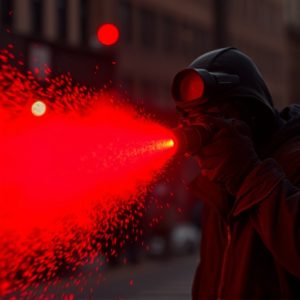Deciphering Capsaicin’s Vision-Impairing Effects and Safety Measures Against Pepper Spray
Capsaicin, the compound responsible for the heat in chili peppers and the active ingredient in pepp…….
Capsaicin, the compound responsible for the heat in chili peppers and the active ingredient in pepper sprays, has a significant impact on pain perception and ocular health. Contrary to myths that it can cause blindness, capsaicin induces temporary but intense irritation upon contact with the eyes, causing acute discomfort, burning sensations, and temporary vision loss due to the stimulation of trigeminal nerves. This reaction is a protective mechanism to clear the irritant and is not a result of actual eye damage but rather an overreaction of the body's pain response system. The research on capsaicin's effects on the eyes has important implications for understanding its potential therapeutic applications, particularly in managing pain-related conditions like dry eye syndrome, as well as for improving safety measures against the misuse of capsaicin. It is crucial to clarify that while pepper spray can be highly uncomfortable and incapacitating, it does not lead to permanent blindness. Understanding its effects helps ensure safe handling in culinary practices and effective use in self-defense scenarios, addressing frequently asked questions such as "Can pepper spray blind you?" Proper first aid involves immediate flushing of the affected area with water for at least 20 minutes and seeking medical attention if capsaicin enters the eyes to prevent long-lasting effects.
Capsaicin, the fiery compound found in chili peppers and the key ingredient in pepper sprays, has a multifaceted impact on human biology. This article delves into the potent effects of capsaicin, particularly its ability to induce intense pain and temporarily impair vision, prompting the question: Can pepper spray blind you? We will unveil the scientific mechanisms behind capsaicin’s interaction with the body, explore the thresholds at which it can cause significant visual disruption, and provide guidance on protective measures and first aid for those exposed to this potent agent. Join us as we navigate the intriguing and sometimes surprising effects of capsaicin.
Unraveling the Mechanisms of Capsaicin: Understanding Its Impact on Vision
Capsaicin, the compound responsible for the pungent heat in chili peppers and hot sauces, has long been studied for its effects on pain perception and gastrointestinal function. However, its impact on vision is an area of growing interest. Scientists hypothesize that capsaicin might affect ocular health due to its ability to bind to the same receptors in the eyes as it does in other pain-sensing tissues. Exposure to high concentrations of capsaicin can lead to a condition known as “chili pepper eye,” where symptoms such as extreme irritation, burning, and temporary blindness can occur. This occurs because capsaicin stimulates the trigeminal nerves, which are responsible for sensing pain and temperature in the face and head, including the eyes. The interaction with these nerves can cause them to misfire, sending false signals that the eye is being damaged, leading to reflexive blinking and tearing to flush out the irritant. While pepper spray is designed to incapacitate by causing intense discomfort and temporary blindness, it’s important to note that the effects are not due to capsaicin ‘blinding’ the eyes but rather inducing an unbearable sensation that makes opening the eyes uncomfortable or impossible. Research into the mechanisms of capsaicin in the visual system continues to shed light on the relationship between ocular physiology and this ubiquitous compound, with implications for both understanding its potential therapeutic uses and ensuring safety against misuse as a weapon. Understanding the molecular pathways involved can also provide insights into treating conditions like dry eye syndrome, where capsaicin has shown promise in managing pain associated with the condition.
The Science Behind Capsaicin and Its Role in Pepper Spray
Capsaicin, the compound responsible for the pungency in chili peppers and the primary irritant in pepper sprays, is a natural defense mechanism for plants belonging to the genus Capsicum. From a scientific standpoint, capsaicin operates by binding to a type of receptor found in sensory neurons called TRPV1, which plays a role in detecting heat and pain. Upon interaction with capsaicin, these receptors send a signal to the brain that is interpreted as heat or pain. This is why consuming foods with high capsaicin content can cause a burning sensation in the mouth and throat.
In the context of self-defense products like pepper spray, capsaicin serves as an effective non-lethal incapacitant. When deployed, it irritates the eyes, skin, and respiratory system of an assailant by stimulating these pain receptors. The intense discomfort caused by capsaicin can lead to tears, pain, and a temporary loss of vision known as “flash-blindness,” which can last from 15 minutes to four hours. This incapacitating effect allows individuals to escape from an attacker. It’s important to note that while pepper spray can cause significant discomfort, it does not typically lead to permanent blindness. Understanding the role of capsaicin in both culinary and defensive applications highlights the versatility of this natural compound.
Exploring the Thresholds: How Much Capsaicin Does It Take to Blind?
Capsaicin, the compound responsible for the heat in chili peppers and the active ingredient in pepper sprays, has varying effects based on exposure levels. When considering the impact of capsaicin on the human eye, it’s crucial to understand that the threshold for discomfort is significantly lower than that for permanent damage or blindness. While high concentrations of capsaicin can cause intense pain and temporary vision impairment, it does not typically lead to blindness. The intensity of the sensation varies with individual tolerance; some individuals may experience severe pain from minimal exposure, while others require a higher dose before feeling the effects. Pepper spray, designed for self-defense, contains capsaicin in a concentrated form that can cause incapacitation through pain compliance. The amount needed to blind is often misunderstood. It’s a common misconception that pepper spray can cause permanent vision loss. In reality, the effects on the eyes are short-lived and primarily consist of intense burning and temporary blindness due to involuntary closure of the eyelids from the pain. Understanding the potency and effects of capsaicin is essential for both its safe handling in culinary practices and its appropriate use in self-defense applications.
Protective Measures and First Aid for Exposure to Capsaicin
Exposure to capsaicin, the active component in chili peppers and pepper sprays, can lead to intense irritation upon contact with skin or mucous membranes. It’s a common misconception that capsaicin can blind you directly; however, it can cause temporary blindness by stimulating the trigeminal nerve, which may lead to involuntary blinking and closing of the eyes, preventing effective vision for a short period. To protect oneself from the effects of capsaicin in self-defense sprays or accidental spills, it is crucial to avoid direct contact. In case of exposure, immediate action is necessary. First aid measures include flushing the affected area with large quantities of water for at least 20 minutes to dilute and remove the capsaicin. Do not use oil-based substances or solvents like soap or alcohol, as they can spread the capsaicin further. It’s also important to keep the person calm and still, as movement can increase the irritation. If the capsaicin has come into contact with the eyes, seek medical attention promptly, even if symptoms initially appear mild. Medical professionals may use a mixture of water and a specific gel to help alleviate the pain and flush out the capsaicin. Understanding the nature of capsaicin exposure and having a clear plan for protective measures and first aid can significantly reduce the severity of its effects.


